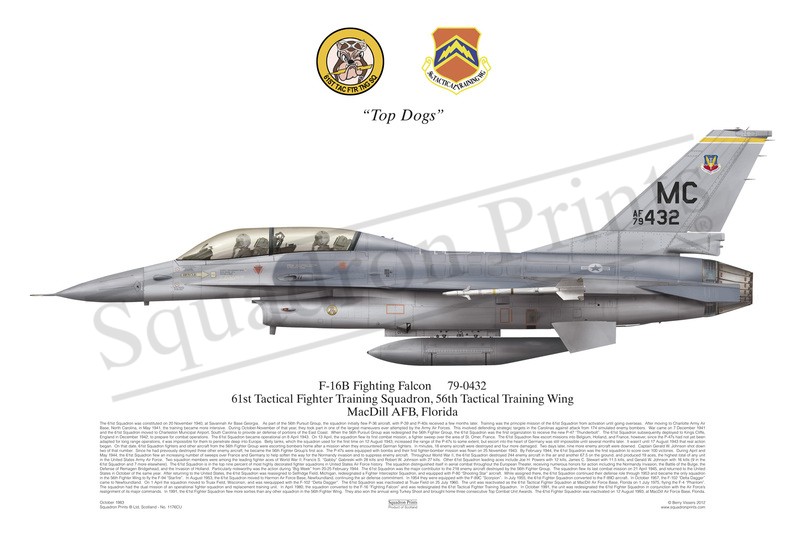#1176CU F-16B Fighting Falcon

Purchased products will not feature the Squadron Prints watermark
Description
Squadron Prints Lithograph No. 1176CU - F-16B Fighting Falcon, 79-0432, 61st Tactical Fighter Training Squadron, 56th Tactical Training Wing, MacDill AFB, Florida.
The 61st Squadron was constituted on 20 November 1940, at Savannah Air Base Georgia. As part of the 56th Pursuit Group, the squadron initially flew P-36 aircraft, with P-39 and P-40s received a few months later. Training was the principle mission of the 61st Squadron from activation until going overseas. After moving to Charlotte Army Air Base, North Carolina, in May 1941, the training became more intensive. During October-November of that year, they took part in one of the largest maneuvers ever attempted by the Army Air Forces. This involved defending strategic targets in the Carolinas against attack from 174 simulated enemy bombers. War came on 7 December 1941 and the 61st Squadron moved to Charleston Municipal Airport, South Carolina to provide air defense of portions of the East Coast. When the 56th Pursuit Group was redesigned the 56th Fighter Group, the 61st Squadron was the first organization to receive the new P-47 \'Thunderbolt\'. The 61st Squadron subsequently deployed to Kings Cliff, England in December 1942, to prepare for combat operations. The 61st Squadron became operational on 8 April 1943. On 13 April, the squadron flew its first combat mission, a fighter sweep over the area of St. Omer, France. The 61st Squadron flew escort missions into Belgium, Holland, and France, however, since the P-47s had not yet been adapted for long range operations, it was impossible for them to penetrate deep into Europe. Belly tanks, which the squadron used for the first time on 12 August 1943, increased the range of the P-47s to some extent, but escort into the heart of Germany was still impossible until several months later. It wasn\'t until 17 August 1943 that real action began. On that date, 61st Squadron fighters and other aircraft from the 56th Fighter Group were escorting bombers home after a mission when they encountered German fighters. In minutes, 18 enemy aircraft were destroyed and four more damaged. Two days later, nine more enemy aircraft were downed. Captain Gerald W. Johnson shot down two of that number. Since he had previously destroyed three other enemy aircraft, he became the 56th Fighter Group\'s first ace. The P-47s were equipped with bombs and their first fighter-bomber mission was flown on 25 November 1943. By February 1944, the 61st Squadron was the first squadron to score over 100 victories. During April and May 1944, the 61st Squadron flew an increasing number of sweeps over France and Germany to help soften the way for the Normandy invasion and to suppress enemy aircraft. Throughout World War II, the 61st Squadron destroyed 244 enemy aircraft in the air and another 67.5 on the ground, and produced 19 aces, the highest total of any unit in the United States Army Air Force. Two squadron members were among the leading fighter aces of World War II; Francis S. \'Gabby\' Gabreski with 28 kills and Robert W. Johnson with 27 kills. Other 61st Squadron leading aces include Joe H. Powers with 12 kills, James C. Stewart with 11.5 kills, and Gerald W. Johnson with 16 kills (9 in the 61st Squadron and 7 more elsewhere). The 61st Squadron is in the top nine percent of most highly decorated fighter squadrons in United States Air Force history. The squadron distinguished itself in aerial combat throughout the European Theater, receiving numerous honors for action including the Normandy Invasion, the Battle of the Bulge, the Defense of Remagen Bridgehead, and the Invasion of Holland. Particularly noteworthy was the action during \'Big Week\' from 20-25 February 1944. The 61st Squadron was the major contributor to the 218 enemy aircraft destroyed by the 56th Fighter Group. The squadron flew its last combat mission on 21 April 1945, and returned to the United States in October of the same year. After returning to the United States, the 61st Squadron was reassigned to Selfridge Field, Michigan, redesignated a Fighter Interceptor Squadron, and equipped with P-80 \'Shooting Star\' aircraft. While assigned there, the 61st Squadron continued their defense role through 1953 and became the only squadron in the 56th Fighter Wing to fly the F-94 \'Starfire\'. In August 1953, the 61st Squadron moved to Harmon Air Force Base, Newfoundland, continuing the air defense commitment. In 1954 they were equipped with the F-89C \'Scorpion\'. In July 1955, the 61st Fighter Squadron converted to the F-89D aircraft. In October 1957, the F-102 \'Delta Dagger\' came to Newfoundland. On 1 April the squadron moved to Truax Field, Wisconsin, and was reequipped with the F-102 \'Delta Dagger\'. The 61st Squadron was inactivated at Truax Field on 25 July 1960. The unit was reactivated as the 61st Tactical Fighter Squadron at MacDill Air Force Base, Florida on 1 July 1975, flying the F-4 \'Phantom\'. The squadron had the dual mission of an operational fighter squadron and replacement training unit. In April 1980, the squadron converted to the F-16 \'Fighting Falcon\' and was redesignated the 61st Tactical Fighter Training Squadron. In October 1991, the unit was redesignated the 61st Fighter Squadron in conjunction with the Air Force\'s realignment of its major commands. In 1991, the 61st Fighter Squadron flew more sorties than any other squadron in the 56th Fighter Wing. They also won the annual wing Turkey Shoot and brought home three consecutive Top Combat Unit Awards. The 61st Fighter Squadron was inactivated on 12 August 1993, at MacDill Air Force Base, Florida.
You may also like
-
SALE KF-16C Fighting Falcon Signed Print
92-011155 FS, 19 FWJung-won AB, Republic of Korea
